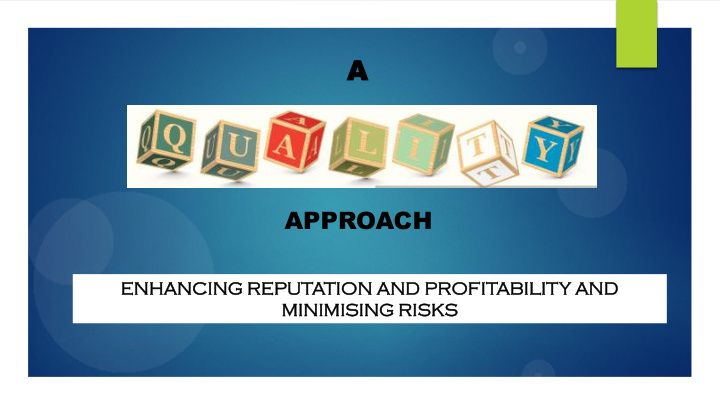



A APPROACH ENHANCING NCING REPUT PUTATI TION ON AND PRO PROFIT ITABILIT BILITY AND MINIMISI IMISING G RISKS
The ‘QUALITY’ Question: Who defines quality? Who really determines what is quality customer service?
The Golden Rule It’s not : Do unto the customer as you would have them do unto you; but Do unto the customer as they would you do unto them!
The Big Question What is the one factor that drives the business performance of an organisation?
TALENTS TEAM MEMBERS ASSOCIATES
The Human Capital For an organisation to successfully build a quality approach into its systems and processes, it must invest in their human capital. “… people are the greatest asset of an organisation; … business leaders know that their success depend on maximising their people – their human capital .” HRCI White Paper
Wither the Role of the Human Resources Manager? Investment in your human capital begins with proper recruitment and hiring practices to attract the best talent to the organisation . RE-ATTRACT ATTRACT Top The right Performers/ Talent Talents
Re-Attract Talent To re-attract and retain talent, the HRM must also develop standards to address: * Orientation * Training * Competence & Evaluation * Counselling * Promotion * Compensation * Discipline * Integrity & Ethical behaviour
The Engagement Profit Chain Kevin Kruse
Employee Engagement? Engagement is defined as: “ The extent to which employees are motivated to contribute to business success, and are willing to apply discretionary effort to accomplishing tasks that are important to the achievement of business goals.”
Employee Engagement: The Critical Link The main factors impacting employee engagement: 1. Supervisors – employees who feel they receive praise and recognition from their supervisors are much more satisfied and engaged than those who do not receive this sort of mentorship. 2. Leadership: employees want to be informed and expect company leaders to effectively and frequently communicate company information and updates. 3. Working Environments – create atmospheres where employees want to come to work; offer incentives or intangible benefits such as flexi-hours.
The Employee Engagement/Employee Satisfaction Relationship Employee engagement Employee Satisfaction but Employee Satisfaction does not mean the employee is Engaged
Engagement Indicators Alignment Achievement Discretionary Pride Advocacy Commitment Effort I understand I am I am proud to I would I intend to stay how my job passionate Willing to go work for this recommend my with my contributes to about beyond what is company company to my company for the success of providing expected for family and the next 5 my company exceptional the success of friends as a years customer my company great place to service work
Drivers of Engagement FUTURE VISION TRUST COMMUNICATION I understand and buy into management’s vision for the I trust that the company leadership This company company. has both its business interests and encourages their employee well-being at heart. employee feedback I understand how my job helps to achieve the company’s goals. and acts upon it when possible.
Drivers of Engagement RECOGNITION GROWTH & DEVELOPMENT This company recognizes its SUPPORT & INCLUSION This company provides employees when they opportunities for do good work. I feel that I am part of a team learning and development.
The relationship between employee satisfaction and customer satisfaction There are several explanations as to why employee satisfaction affects customer satisfaction: Employees that interact with customers are in a position to develop awareness of and respond to customer goals and needs. Satisfied employees are motivated employees. Satisfied employees are empowered employees. Takes initiative.
The relationship between employee satisfaction and customer satisfaction Satisfied employees have high energy and willingness to give good service. Satisfied employees can provide customers with ‘interpersonal sensibilities’. Engaged, satisfied employees are more likely to provide AMAZING Customer Service which will ensure big profits.
A quality approach does not mean mistakes would not happen. A service-centric organisation will use an unhappy customer as an opportunity to turn that customer around to make them not only satisfied but loyal to the organisation. What is the service culture in your organisation? Fix the problem before the dissatisfied customer leave your establishment – don’t wait for a letter, or negative post on Trip Advisor. Always ask the question – What can we do to make it better?
Types of Employees
Company Introspection What do you believe is hampering your company’s ability to provide consistent service excellence? 1. Not hiring the right-fit employee for your organisation? 2. You have too many unhappy and disengaged employees who are not leaving the company? 3. There are too many systems and processes hampering the operation? 4. Your manager and supervisors do not know how to motivate others?
Company Introspection 5. Is it that you need to actively engage your team? 6. Is it that the company’s vision and mission is not clearly communicated from the top-down? 7. What rewards and recognition programmes do you have in place? 8. Is our service culture giving us the results we want?
In Conclusion: For a company to successfully implement a quality approch so as to enhance its reputation and profitability and minimize risk, priority must be given to devloping the employee / human capital of the orgnization. Only CHAMPIONS will get you where you want to go!!
Recommend
More recommend